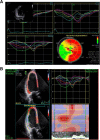Role of cardiac imaging in Anderson-Fabry cardiomyopathy
- PMID: 30674321
- PMCID: PMC6345038
- DOI: 10.1186/s12947-019-0151-5
Role of cardiac imaging in Anderson-Fabry cardiomyopathy
Abstract
The Anderson-Fabry disease (AFD, or simply Fabry Disease, FD; MIM #301500) is a rare X-linked lysosomal storage disorder (Xq22.1) characterized by progressive renal failure, leading to morbidity through cardio- and cerebro-vascular involvement. Despite the classic phenotype, only cardiac involvement (cardiac variant of AFD; MIM 301500) is frequent in about 40% of male and 28% of female AFD patients, as reported by the Fabry Registry ( https://www.registrynxt.com ). Morphologically, the cardiac characteristic of the disease, occurs as left ventricular hypertrophy, is accompanied by myocardial fibrosis. Cardiologists may come across these patients during clinical and instrumental evaluation in individuals with non-specific symptoms such as chest pain and arrhythmias, or after instrumental evidence of left ventricular hypertrophy/hypertrophic cardiomyopathy (HCM; MIM 192600). A comprehensive cardiological work-up, including a cardiological visit, a baseline electrocardiogram (ECG) and imaging by both echocardiography (ECHO) and magnetic resonance (MRI) enables identification of the cardiac involvement in patients with a proven diagnosis of AFD. The heart involvement is present in up to 75% of AFD patients irrespective of their sex. Involvement includes ECG and echocardiography features which suggest AFD and not HCM. Cardiac imaging plays an important role in detecting this sub-type of cardiomyopathy, which, since 2001, has benefited from the introduction of the enzyme replacement therapy (ERT) in symptomatic and pre-symptomatic patients.
Conflict of interest statement
Authors’ information
Not applicable.
Ethics approval and consent to participate
Not available.
Competing interests
The authors declare that they have no competing interests.
Publisher’s Note
Springer Nature remains neutral with regard to jurisdictional claims in published maps and institutional affiliations.
Figures



Similar articles
-
Severe hypertrophic cardiomyopathy in a patient with atypical Anderson-Fabry disease.Future Cardiol. 2017 Nov;13(6):521-527. doi: 10.2217/fca-2017-0011. Epub 2017 Sep 22. Future Cardiol. 2017. PMID: 28936893
-
Anderson-Fabry cardiomyopathy: prevalence, pathophysiology, diagnosis and treatment.Heart Fail Rev. 2015 Mar;20(2):179-91. doi: 10.1007/s10741-014-9452-9. Heart Fail Rev. 2015. PMID: 25030479 Review.
-
[Cardiological follow-up in patients with Fabry disease].G Ital Cardiol (Rome). 2010 Jul-Aug;11(7-8):566-72. G Ital Cardiol (Rome). 2010. PMID: 21033333 Review. Italian.
-
The role of cardiovascular multimodality imaging in the evaluation of Anderson-Fabry disease: from early diagnosis to therapy monitoring.Eur Heart J Cardiovasc Imaging. 2025 Apr 30;26(5):814-829. doi: 10.1093/ehjci/jeaf038. Eur Heart J Cardiovasc Imaging. 2025. PMID: 39903606
-
Left ventricular hypertrophy: do not forget Fabry disease. Diagnostic work-up and differential diagnosis.Acta Cardiol. 2024 Aug;79(6):642-649. doi: 10.1080/00015385.2024.2346873. Epub 2024 Jun 13. Acta Cardiol. 2024. PMID: 38869089 Review.
Cited by
-
[The Role of Cardiac MRI in the Diagnosis of Fabry Disease].Taehan Yongsang Uihakhoe Chi. 2020 Mar;81(2):302-309. doi: 10.3348/jksr.2020.81.2.302. Epub 2020 Mar 31. Taehan Yongsang Uihakhoe Chi. 2020. PMID: 36237382 Free PMC article. Review. Korean.
-
Twenty years of the Fabry Outcome Survey (FOS): insights, achievements, and lessons learned from a global patient registry.Orphanet J Rare Dis. 2022 Jun 20;17(1):238. doi: 10.1186/s13023-022-02392-9. Orphanet J Rare Dis. 2022. PMID: 35725623 Free PMC article. Review.
-
Cardiovascular magnetic resonance versus echocardiography derived left ventricular ejection fraction for decision-making.Future Cardiol. 2024 Dec-Dec;20(15-16):811-814. doi: 10.1080/14796678.2024.2426875. Epub 2024 Nov 14. Future Cardiol. 2024. PMID: 39539213 No abstract available.
-
The role of echocardiography for diagnosis and prognostic stratification in hypertrophic cardiomyopathy.J Echocardiogr. 2020 Sep;18(3):137-148. doi: 10.1007/s12574-020-00467-9. Epub 2020 Apr 16. J Echocardiogr. 2020. PMID: 32301048 Free PMC article. Review.
References
-
- 2014 ESC Practice Guidelines on diagnosis and management of hypertrophic cardiomyopathy Eur Heart Journal (2014) 35:2733–2779 -10.1093/eurheartj/ehu284 . - PubMed
-
- Serra W, Fagnani S, Ardissino D, Gherli T. Late-onset cardiac variant of Fabry disease responsive to short-term treatment with Agalsidase alpha. J Clinic Experiment Cardiol. 2010;1:109. 10.4172/2155-9880.1000109.
Publication types
MeSH terms
LinkOut - more resources
Full Text Sources
Medical

